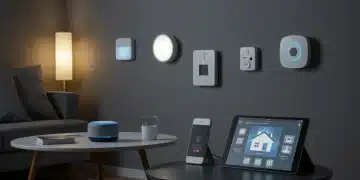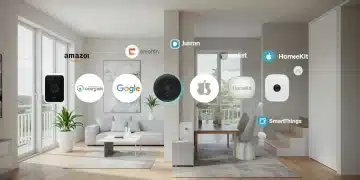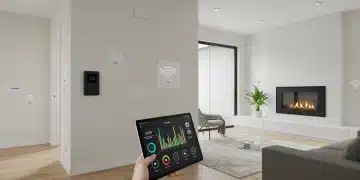Latest Smart Home Hubs: 2025 Deep Dive for US Consumers
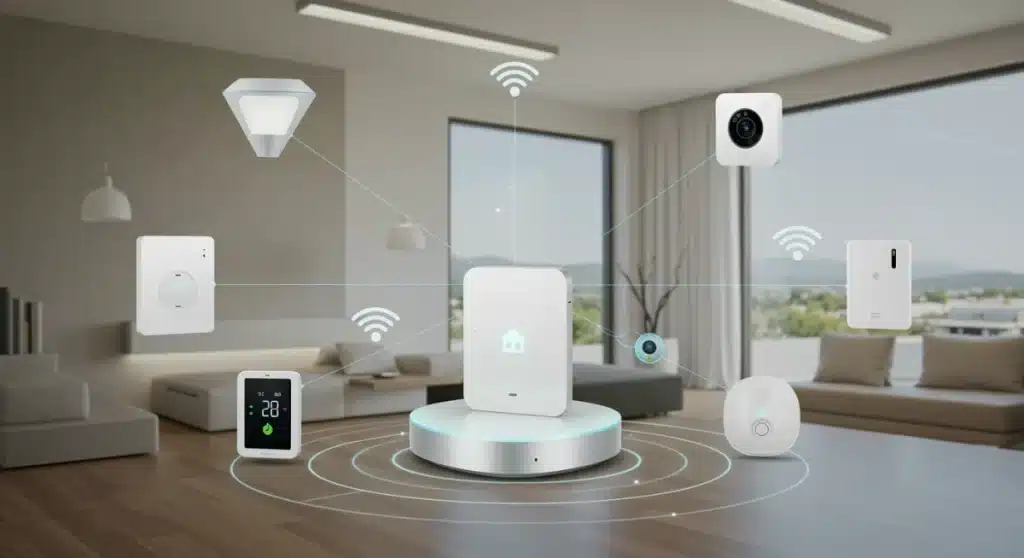
The smart home landscape is rapidly evolving in 2025, with new hubs prioritizing Matter and Thread integration, enhanced AI capabilities, and robust security features for US consumers.
As of early 2025, the smart home market for US consumers is experiencing significant shifts. The introduction of new and updated smart home hubs is redefining connectivity, automation, and user experience. This deep dive focuses on The Latest Smart Home Hubs: A 2025 Deep Dive for US Consumers (RECENT UPDATES), highlighting key innovations and what they mean for your connected living space.
The Rise of Universal Connectivity: Matter and Thread Integration
Universal connectivity standards like Matter and Thread are no longer just buzzwords; they are now foundational elements in the latest smart home hubs. These protocols aim to simplify device setup and ensure seamless interoperability across different brands, a critical development for US consumers navigating a crowded market.
Major manufacturers are actively integrating these standards into their 2025 hub offerings. This move is expected to resolve many of the compatibility issues that have historically plagued smart home ecosystems, making it easier for users to expand their setups without worrying about brand-specific limitations.
Matter: The Unifying Standard
Matter, spearheaded by the Connectivity Standards Alliance (CSA), is designed to be the language all smart devices speak. Its implementation in current generation hubs means a device certified with Matter will work with any Matter-certified controller, regardless of brand.
- Simplified Setup: Devices can be onboarded quickly and easily.
- Enhanced Compatibility: Works across ecosystems like Apple HomeKit, Google Home, Amazon Alexa, and Samsung SmartThings.
- Local Control: Many Matter-enabled devices can operate locally, improving responsiveness and reliability.
Thread: The Mesh Network Foundation
Thread provides a low-power, self-healing mesh networking protocol that enhances device communication. It works in conjunction with Matter, providing the underlying network infrastructure for many Matter-enabled devices to communicate efficiently and reliably.
The synergy between Matter and Thread is crucial for the stability and scalability of 2025 smart homes. Hubs with built-in Thread border router capabilities are becoming standard, extending the range and robustness of smart device networks within homes.
Advanced AI and Machine Learning Capabilities
Artificial intelligence and machine learning are transforming smart home hubs from mere control centers into intelligent assistants. The latest hubs leverage AI to learn user habits, anticipate needs, and automate routines with unprecedented precision and personalization.
This goes beyond simple scheduling; AI-powered hubs can adapt to real-time conditions, such as weather changes, occupancy patterns, and even energy prices, to optimize home performance and comfort. For US consumers, this translates into more efficient and responsive home automation.
Personalized Automation
New AI algorithms allow hubs to create highly personalized automation sequences. For example, a hub might learn your preferred lighting levels at different times of day or adjust the thermostat based on your family’s daily schedule and outdoor temperatures.
- Predictive Actions: Anticipates needs like pre-cooling the house before arrival.
- Routine Learning: Automatically adjusts settings based on observed patterns.
- Contextual Awareness: Responds to environmental factors and user presence.
Voice Assistant Evolution
While voice assistants have been a staple, their integration with advanced AI in 2025 hubs makes them more intuitive and capable. Natural language processing has improved, allowing for more complex commands and conversational interactions.
Hubs are now better at understanding context and intent, reducing the need for precise phrasing. This makes interacting with your smart home more fluid and less frustrating, bringing a new level of convenience to daily tasks.
Enhanced Security and Privacy Features
As smart homes become more sophisticated, so does the concern for security and privacy. The latest smart home hubs address these concerns head-on, integrating advanced encryption, local processing, and robust access controls to protect user data and ensure home safety.
Manufacturers recognize that trust is paramount. Consequently, 2025 hubs are designed with privacy by design principles, offering transparency about data collection and providing users with greater control over their personal information. This focus is a direct response to consumer demand for more secure connected environments.
Robust Data Encryption
All communication between devices and the hub, and often to the cloud, is now secured with state-of-the-art encryption. This prevents unauthorized access to sensitive data, such as security camera feeds or personal schedules.
Many hubs are also moving towards end-to-end encryption for specific data streams, providing an even higher level of protection against potential breaches. This is a significant improvement over earlier generations of smart home technology.
Local Processing and Edge AI
A growing trend is the shift towards more local processing of data. By performing AI computations and processing sensitive information directly on the hub, rather than sending it all to the cloud, privacy risks are significantly reduced. This also improves response times for critical automations.
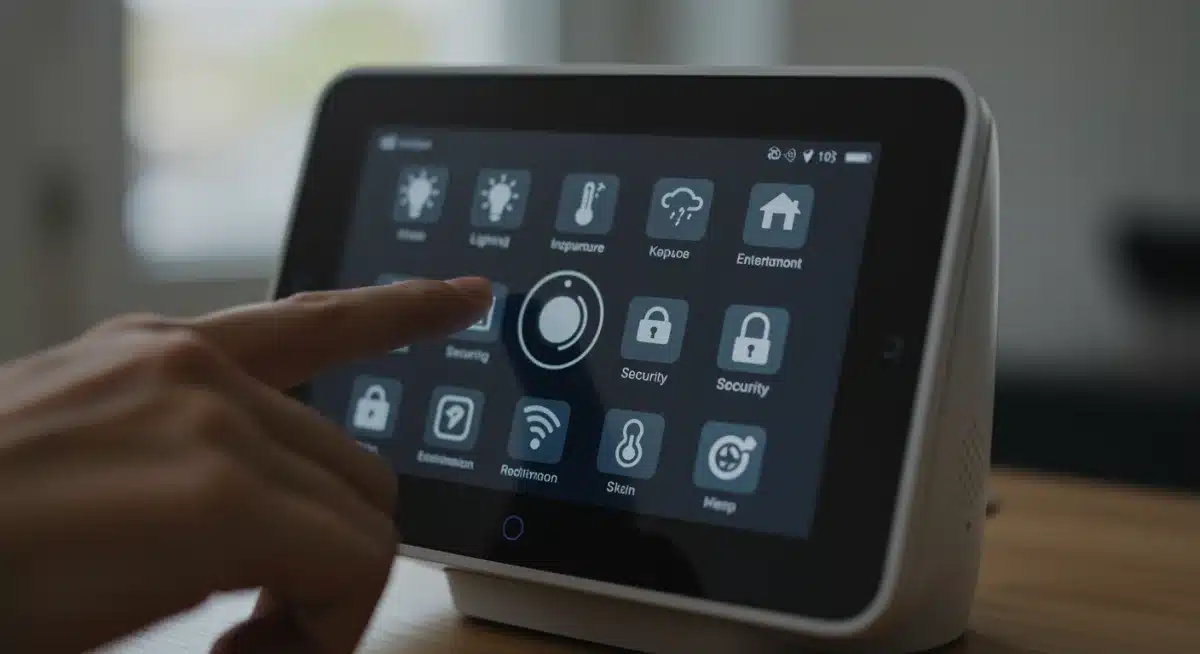
Edge AI capabilities mean that the hub can make intelligent decisions without constant internet connectivity, adding an extra layer of reliability and privacy. This is particularly important for security systems and personal data handling.
Integration with Sustainable Living and Energy Management
Sustainability is a core focus for 2025 smart home hubs. These devices are increasingly designed to help US consumers monitor and reduce their energy consumption, contributing to both environmental preservation and lower utility bills. Integration with smart grids and renewable energy sources is also on the horizon.
These hubs go beyond simple energy monitoring; they actively manage energy usage by optimizing device operation based on real-time energy prices, peak demand periods, and even the availability of solar or wind power if integrated with home energy systems.
Smart Energy Monitoring
The latest hubs provide granular insights into energy usage across all connected devices. Users can see exactly where their energy is going and identify opportunities for savings.
- Real-time Data: Instant feedback on energy consumption.
- Usage Reports: Detailed historical data to track trends.
- Anomaly Detection: Alerts for unusual energy spikes that might indicate problems.
Dynamic Energy Optimization
Beyond monitoring, hubs are now actively optimizing energy usage. This includes adjusting thermostat settings during peak hours, scheduling power-intensive appliances for off-peak times, and even integrating with electric vehicle charging to optimize costs.
This dynamic management capability positions smart home hubs as central components in a more sustainable and cost-effective household. The focus is on making energy efficiency effortless for the end-user.
User Experience and Interface Innovations
The user experience (UX) of smart home hubs has undergone a significant overhaul. 2025 models feature more intuitive interfaces, streamlined setup processes, and customizable dashboards, making smart home management accessible to a broader audience of US consumers.
The goal is to simplify complexity, allowing users to effortlessly control their entire home from a single, cohesive interface. This includes both physical touchscreens on the hubs themselves and companion mobile applications.
Intuitive Dashboards
Modern hubs offer highly customizable dashboards that allow users to prioritize and display the most relevant information and controls. This might include quick access to security camera feeds, climate controls, or lighting scenes.
The design philosophy emphasizes clarity and ease of navigation, ensuring that even novice users can quickly become proficient in managing their smart home. Widgets and personalized layouts are becoming standard features.
Simplified Setup and Onboarding
Gone are the days of complex pairing processes. The latest hubs leverage technologies like QR codes, NFC, and Bluetooth Low Energy for quick and seamless device onboarding. This greatly reduces the barrier to entry for new smart home adopters.
Step-by-step guides and intelligent device recognition help users get their new devices connected and integrated into their home ecosystem with minimal effort, making the initial setup a far more pleasant experience.
Future-Proofing Your Smart Home Investment
Investing in a smart home hub in 2025 means considering its longevity and adaptability. The latest hubs are designed with future-proofing in mind, supporting over-the-air (OTA) updates, modular expandability, and compatibility with emerging technologies.
This ensures that your smart home ecosystem can evolve with new standards and devices without requiring a complete overhaul every few years. For US consumers, this represents a crucial aspect of long-term value and satisfaction.
Over-the-Air Updates and Longevity
Regular software updates are critical for security, performance, and compatibility with new devices. 2025 hubs are built to receive frequent OTA updates, ensuring they remain current with the latest protocols and features.
- Feature Enhancements: New capabilities added post-purchase.
- Security Patches: Protection against new vulnerabilities.
- Compatibility Updates: Support for future smart devices and standards.
Modular and Expandable Design
Some advanced hubs offer modular designs, allowing users to add new functionalities through expansion modules. This could include adding support for new wireless protocols or enhancing processing power as needs evolve.
This approach provides flexibility and protects the initial investment, as users can upgrade specific components rather than replacing the entire hub. It’s a strategic move by manufacturers to cater to the dynamic nature of the smart home market.
| Key Aspect | 2025 Innovation Summary |
|---|---|
| Connectivity Standards | Widespread adoption of Matter and Thread for universal device interoperability and simplified setup. |
| AI & Automation | Advanced AI for personalized automation, predictive actions, and more intuitive voice assistant interactions. |
| Security & Privacy | Enhanced data encryption, local processing, and privacy-by-design principles for user data protection. |
| Sustainability Focus | Integration with energy management, real-time monitoring, and dynamic optimization for reduced consumption. |
Frequently Asked Questions About 2025 Smart Home Hubs
The most significant change is the widespread adoption and deep integration of Matter and Thread connectivity standards. These protocols are crucial for ensuring universal compatibility, simplifying device setup, and creating more robust, reliable smart home ecosystems for US consumers.
New AI features enable hubs to learn user behaviors and preferences, leading to highly personalized and predictive automation. This means your home can anticipate needs, optimize settings for comfort and efficiency, and respond more intelligently to your daily routines without constant manual input.
Yes, security and privacy are top priorities. The latest hubs feature enhanced data encryption, increased local processing of sensitive data (Edge AI), and more transparent privacy controls. These advancements minimize reliance on cloud services for critical operations, boosting both security and privacy.
Absolutely. 2025 smart home hubs are increasingly focused on sustainability. They offer advanced energy monitoring, real-time usage reports, and dynamic optimization features that can automatically adjust device operation to minimize energy waste and integrate with smart grids for cost-effective management.
Future-proofing refers to the hub’s ability to adapt to evolving technology. This includes supporting over-the-air (OTA) software updates for new features and security patches, and sometimes modular designs that allow hardware upgrades. This ensures your investment remains relevant as the smart home landscape changes.
What Happens Next
The current trajectory for smart home hubs indicates a future where seamless integration and intelligent automation are the norms, not the exceptions. As Matter and Thread continue to mature, we anticipate even greater device diversity and simplified user experiences. The emphasis on AI-driven personalization and robust cybersecurity will only intensify, responding to consumer demands for both convenience and peace of mind. US consumers should watch for further innovations in energy management and predictive analytics, as manufacturers push the boundaries of what a truly smart home can achieve. These developments suggest a continually evolving, more intuitive, and highly secure connected living environment.
